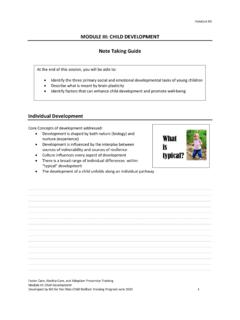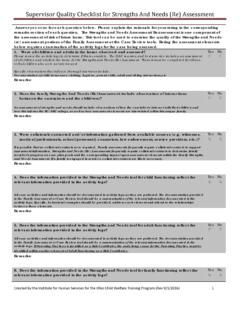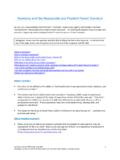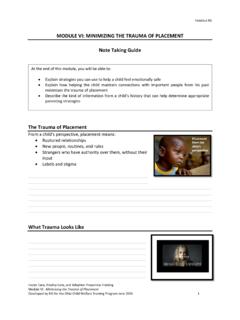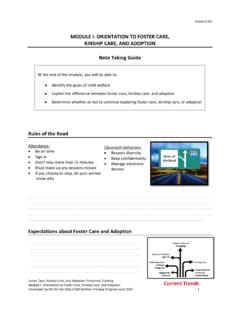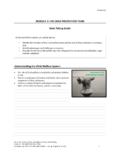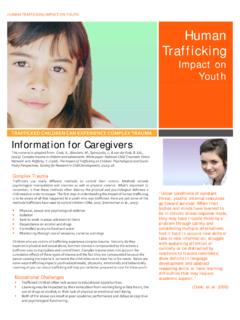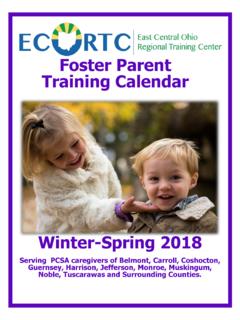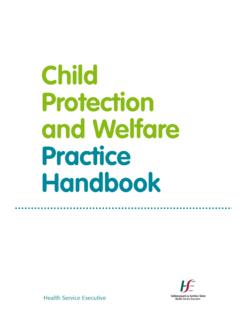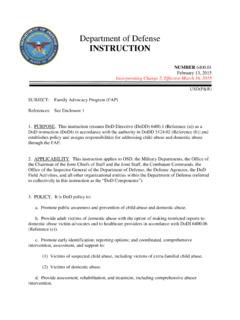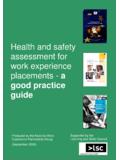Transcription of Supervisor Quality Assessment of Safety Checklist …
1 Supervisor Quality Safety Assessment Checklist Developed by the Institute for Human Services and the Ohio Department of Job and Family Services, CPS Policy for the Ohio child Welfare Training Program- June 2015 1 of 7 For each item below, answer the corresponding question. If a No is selected, please describe your reasoning. Completion of this Quality Assessment of Safety Checklist will require you to review the intake and case activity logs. While detailed information is routinely presented in the case activity logs, summarizations included in the Safety Assessment Tools often do not include all the relevant information that reflects the complete picture of the Safety of the child . If, upon completion of this tool, you identify that the Safety Assessment needs supporting documentation included in the tool, use this document to identify what areas need improvement.
2 Collecting Information: 1. Does the information in the Safety Assessment tool (initial, review, etc) reflect the relevant information provided in the activity logs? All case activities and information should be documented in activity logs as they are gathered. The documentation provided in the Safety Assessment tool should be a summarization of the relevant information documented in the activity logs. Yes No Remarks: 2. Were all children in the home observed and interviewed? Please review the intake and activity logs to determine if this is complete. While OAC requires only the child subject of the report/ACV to be interviewed for the initial Assessment of Safety , best practice would include an interview of all children and adults in the home for the Assessment of Safety .
3 Specific observations that indicate thorough interviews include: Documentation of child demeanor, clothing, hygiene, parent- child interactions, etc. Yes No Remarks: 3. If necessary, was the child (ren) interviewed alone? Specific factors to consider when making the determination about if the child (ren) should be interviewed alone: In the TR pathway, children should always be interviewed alone if developmentally appropriate Any information that you receive that suggests that a complete picture of child Safety would be compromised without this interview Yes No Remarks: Supervisor Quality Safety Assessment Checklist Developed by the Institute for Human Services and the Ohio Department of Job and Family Services, CPS Policy for the Ohio child Welfare Training Program- June 2015 2 of 7 4.
4 Was at least one parent, guardian, or caretaker in the home interviewed? Please review the intake and activity logs to determine if this is complete. While OAC requires at least one parent/guardian/custodian/caregiver responsible for the daily care of the child to be interviewed for the initial Assessment of Safety , best practice would include an interview of all children and adults in the home for the Assessment of Safety . Specific observations that indicate thorough interviews include: Documentation of adult demeanor, clothing, hygiene, parent- child interactions, etc. Yes No Remarks: 5. Was the living environment observed and the Safety of the living environment documented? Please review the activity logs to determine if this is complete. Examples of specific observations that indicate this occurred: Yes No Housing is unsanitary, filthy, infested, a health hazard Excessive garage or rotted or spoiled food which threatens healthy Physical structure of the house is decaying, falling down Exposed electrical wiring within reach of children Medications, hazardous chemicals, alcohol/drugs, or loaded weapons accessible to children Gas leak Children have access to potentially dangerous pets in the home Excessive cockroaches, mice, rats, etc.
5 Present in the home Remarks: 6. Is the information included in the Assessment credible (believable, reliable)? Review activity logs and discuss the Assessment with the worker to fully understand if the information included is credible. Yes No Remarks: Supervisor Quality Safety Assessment Checklist Developed by the Institute for Human Services and the Ohio Department of Job and Family Services, CPS Policy for the Ohio child Welfare Training Program- June 2015 3 of 7 7. Based upon activity logs and the rationale provided within the tool, is the correct response (yes or no) chosen for all Safety factors? Each Safety factor must be rated as yes or no . Yes No Remarks: 8. Is there descriptive and specific rationale provided to support all no and yes responses?
6 Narrative must be provided to support the response for each Safety factor. The narrative should include observations of behaviors or situations that support the rating. Yes No Remarks: child Vulnerability: 9. Does the Assessment provide a comprehensive description of each child s vulnerability to child abuse and/or neglect that is supported by examples whenever possible? The Assessment of child vulnerability should include a description of each of the five domains outlined below. Examples of those characteristics that contribute to vulnerability in each domain are listed. Yes No Physical Young 0-5 Cannot verbalize maltreatment is occurring Appearance provokes parental hostility Unable to remove him/herself from a situation Small height or weight Physical appearance does not fit cultural norms Physical disability/diagnosis that requires special care Cognitive Cannot recognize actions that are neglectful/abusive Cognitive disability or delay Lacks ability to problem solve Unable to understand cause and effect Unable to communicate Believes they are powerless Emotional Requires intensive physical care Does not demonstrate an attachment to his or her caretaker Distractibility Cannot tolerate frustration Requires intense emotional support from his or her caretaker Lacks the ability to deescalate him/her self Passive and easily
7 Influenced Overly sensitive to physical touch Behavioral Provocative behaviors Defiant Resists parental authority Diagnosis that impacts their behavior Argumentative Supervisor Quality Safety Assessment Checklist Developed by the Institute for Human Services and the Ohio Department of Job and Family Services, CPS Policy for the Ohio child Welfare Training Program- June 2015 4 of 7 Historical History of abuse Experienced chronic neglect in his or her live Experienced repeated victimization child feared a member of the family system Non-Communicative regarding their history of abuse/neglect Passive as a result of past maltreatment Power and control were used to intimidate the child within the family system. High energy level Engaged in crimes with parents Unable to self-soothe Seeks negative attention by agitating others Sexually provocative behaviors Reacts intensely to the environment Unruly/Delinquent Demonstrates fear of a member of the family Parentified behavior Remarks: 10.
8 If child vulnerabilities were not fully explained, please identify which vulnerability elements need further exploration. Please describe those domains that need further exploration: Physical Emotional (Personality) Cognitive Behavioral Historical Protective Capacities: 11. Does the Assessment identify the individual strengths and resources for each adult that can reduce, control and/or prevent specific Safety threats? If no, what characteristics noted in the caseworker s activity logs may be identified as strengths? What does the caseworker need to do in order to explore strengths? Also, provide comments on characteristics listed as protective capacities that do not reduce or control Safety threats. Yes No Remarks: Supervisor Quality Safety Assessment Checklist Developed by the Institute for Human Services and the Ohio Department of Job and Family Services, CPS Policy for the Ohio child Welfare Training Program- June 2015 5 of 7 12.
9 Were concrete, behavioral examples to describe how each adult is able, capable and willing to use their protective capacities to ensure child Safety included in the Assessment ? Or was the absence of any protective capacity documented? Specific examples of each category of protective capacities are listed below. Yes No Please note any examples or deficits in protective capacities that need to be added to the Assessment of Safety based upon a review of the Safety Assessment , activity logs, and case discussions: Behavioral The caretaker has a history of protecting The caretaker exhibits self-control The caretaker comforts the child The caretaker is physically able to parent The caretaker possesses adequate energy The caretaker physically intervenes when child attempts dangerous act The caretaker creates an organized and routinized home environment for the child The caretaker demonstrates the ability to adjust to change The caretaker is able to provide structure for their child The caretaker demonstrates support for the child The caretaker utilizes resources to meet the child s basic needs The caretaker provides the child s basic needs The caretaker demonstrates impulse control The caretaker tolerates the stress of parenting The caretaker demonstrates love.
10 Empathy and sensitivity toward the child The caretaker assigns chores appropriate to the child s age and development The caretaker takes the child to all necessary medical appointments The caretaker defers her or his own needs to meet the needs/wants of the child . The caretaker provides the child with supervision appropriate to age and stage of development The caretaker utilizes a support network to assist in caring for the child when necessary The caretaker uses safe/effective coping skills with caring for the child The caretaker has a capable/competent person supervising the children in the caretaker s absence The caretaker demonstrates adequate skill in fulfilling caretaking responsibilities The caretaker demonstrates tolerance in response to the stresses of parenting The caretaker protects the child from potential harm The caretaker displays affection for the child (hugs, tenderness, consoles the child )
